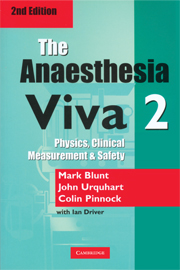1 - Questions on Physics
Published online by Cambridge University Press: 05 February 2015
Summary
1. WHAT ARE THE PHYSICAL PRINCIPLES OF A ‘ROTAMETER’?
A ‘rotameter’ is a variable-orifice flowmeter that allows a continuous indication of gas flow.
Within the rotameter a bobbin is supported by the gas flow within the conical glass tube. As the flow increases the bobbin rises so there is more space around the bobbin. Thus the bobbin is suspended with a variable orifice around it, and the size of the orifice therefore depends on the gas flow. The pressure drop across the bobbin is constant and equal to the weight (mass × gravity) of the bobbin divided by the cross sectional area of its base. The area of the ring around the bobbin increases as the bobbin rises, so as the flow increases the pressure drop across the bobbin remains constant.
The flow around the bobbin is a mixture of laminar and turbulent flow, due to the complex shape of the orifice. At low flows the area of the orifice is small, and it behaves like a thin tube, with the flow being more laminar, whereas higher up the area is larger relative to the length of the bobbin, and it behaves more like a short constriction in a tube, so the flow is more turbulent. Each rotameter is calibrated for the specific gas that it will measure.
- Type
- Chapter
- Information
- The Anaesthesia Viva , pp. 3 - 34Publisher: Cambridge University PressPrint publication year: 2003



